Eleocharis compressa (Flatstem Spikerush)
| Also known as: | Flattened Spikerush, Flat-stemmed Spike-sedge |
|---|---|
| Genus: | Eleocharis |
| Family: | Cyperaceae (Sedge) |
| Life cycle: | perennial |
| Origin: | native |
| Habitat: | sun; wet, calcareous soil; fens, sedge meadows, seeps, ditches, shores, prairie swales, dolomite outcrops and bluffs |
| Fruiting season: | July - September |
| Plant height: | 3 to 16 inches |
| Wetland Indicator Status: | GP: FACW MW: FACW NCNE: FACW |
| MN county distribution (click map to enlarge): |  |
| National distribution (click map to enlarge): |  |
Pick an image for a larger view. See the glossary for icon descriptions.
Detailed Information
Flower: 

![[photo of spike]](/udata/r9ndp23q/grass/eleocharis-compressa-060917-2-t.jpg) A single spike at the top of the stem, lance-elliptic in outline, blunt to pointed at the tip, 4 to 10 mm (to ~3/8 inch) long, with 20 to 60 florets spirally arranged, each floret subtended by a single scale. Scales are 2 to 3.5 mm long, pointed at the tip, reddish-brown to dark brown with a brown to straw-colored midrib and a wide band of whitish translucent edging. The scale tip is usually deeply cut, especially in the mid to lower spike, the whitish part at least .6 mm long and typically longer than wide. Florets have 3 stamens and usually a 3-parted style, sometimes 2-parted. The lowest scale in the spike is rounded and not notched at the tip, wraps 75-100% of the stem, and lacks a flower. The second lowest scale may have a flower.
A single spike at the top of the stem, lance-elliptic in outline, blunt to pointed at the tip, 4 to 10 mm (to ~3/8 inch) long, with 20 to 60 florets spirally arranged, each floret subtended by a single scale. Scales are 2 to 3.5 mm long, pointed at the tip, reddish-brown to dark brown with a brown to straw-colored midrib and a wide band of whitish translucent edging. The scale tip is usually deeply cut, especially in the mid to lower spike, the whitish part at least .6 mm long and typically longer than wide. Florets have 3 stamens and usually a 3-parted style, sometimes 2-parted. The lowest scale in the spike is rounded and not notched at the tip, wraps 75-100% of the stem, and lacks a flower. The second lowest scale may have a flower.
Leaves and stems: 

![[photo of sheaths]](/udata/r9ndp23q/grass/eleocharis-compressa_0607_090043-t.jpg) The 2 leaves are bladeless and reduced to sheaths on the lower stem. The upper sheath is membranous, reddish toward the base, green to straw-colored towards the tip, straight across or nearly so at the tip, may be darker reddish-brown around the tip edge, and may have an obscure to distinct tooth at the apex.
The 2 leaves are bladeless and reduced to sheaths on the lower stem. The upper sheath is membranous, reddish toward the base, green to straw-colored towards the tip, straight across or nearly so at the tip, may be darker reddish-brown around the tip edge, and may have an obscure to distinct tooth at the apex.
![[photo of twisted stems]](/udata/r9ndp23q/grass/eleocharis-compressa_0607_085904-t.jpg) Stems are sometimes nearly round in cross-section but more often compressed to 5 times as wide as thick (oblong-elliptic in cross-section), .5 to 1.8 mm wide, smooth or with 2 to 12 vertical ridges, and are often spirally twisted. Stems are erect and form mats from slender rhizomes.
Stems are sometimes nearly round in cross-section but more often compressed to 5 times as wide as thick (oblong-elliptic in cross-section), .5 to 1.8 mm wide, smooth or with 2 to 12 vertical ridges, and are often spirally twisted. Stems are erect and form mats from slender rhizomes.
Fruit: 
![[photo of scales and achenes]](/udata/r9ndp23q/grass/eleocharis-compressa-060917-4-t.jpg) Each flower produces a single achene (seed), that usually drops off with the scale, the achene with a cap-like appendage (tubercle) at the tip that is clearly distinct from the rest of the achene. Scales become spreading in fruit, and some achenes occasionally persist on the spike even when mature. Achenes are .8 to 1.1 mm long, .6 to .8 mm wide, yellow to orange to dark brown, covered in a fine network pattern across the surface, 3-sided to nearly lens-shaped in cross-section, urn-shaped in outline, rounded at the tip end and tapering at the base. Tubercles are greenish to brown, pyramidal and usually depressed, .1 to .3 mm long, mostly wider than long. There is barely a neck/constriction between the tip of the achene and the base of the tubercle. Surrounding the achene are 0 to 5 (often 0) barbed, yellowish to whitish bristles of varying lengths, up to as long as the achene.
Each flower produces a single achene (seed), that usually drops off with the scale, the achene with a cap-like appendage (tubercle) at the tip that is clearly distinct from the rest of the achene. Scales become spreading in fruit, and some achenes occasionally persist on the spike even when mature. Achenes are .8 to 1.1 mm long, .6 to .8 mm wide, yellow to orange to dark brown, covered in a fine network pattern across the surface, 3-sided to nearly lens-shaped in cross-section, urn-shaped in outline, rounded at the tip end and tapering at the base. Tubercles are greenish to brown, pyramidal and usually depressed, .1 to .3 mm long, mostly wider than long. There is barely a neck/constriction between the tip of the achene and the base of the tubercle. Surrounding the achene are 0 to 5 (often 0) barbed, yellowish to whitish bristles of varying lengths, up to as long as the achene.
Notes:
Eleocharis compressa is one of several colony-forming Spikerushes in Minnesota and can be difficult to distinguish from some of the others even when achenes are present. The achenes are virtually identical to those of Eleocharis elliptica, and the two were at one time considered varieties of a single species and are still identified as such in some references. Both may be found in a variety of wet habitats, from road ditches to sedge meadows to seeps and seasonally wet depressions, often in calcareous soils.
E. compressa is distinguished by the compressed stems that are often slightly twisted, floral scales with a deep cut at the tip that become spreading in fruit, usually yellow-orange achenes about 1 mm long with a conspicuous network pattern across the surface, achenes sometimes persisting on the spike after scales drop off, up to 5 bristles (often absent) of varying lengths, small tubercle depressed and usually wider than long. The spike is normally lance-elliptic, blunt at the tip, with brown scales and the second lowest scale may have a flower/fruit. There are 2 recognized varieties, both of which are in Minnesota: var. compressa has stems compressed 2 to 5 times as wide as thick and sheaths lack a tooth at the apex; var. acutisquamata stems are compressed not more than 2 times as wide as thick and sheaths often have a tooth at the apex.
By comparison, E. elliptica floral scales are not notched at the tip or only shallowly notched, the whitish edging on the scale tip not longer than wide, stems are typically round in cross-section and not twisted, and most achenes persist on the spike long after the scales fall off. The achenes are also similar to those of Eleocharis nitida, which is a much more diminutive plant with smaller achenes and only found in northeast MN. Also similar is Eleocharis wolfii, which has very flat stems more strongly twisted, its floral scales are not notched at the tip, achenes are more narrow with rows of ridges and cross-bars, sheaths loosely wrap the stem and are more papery and fragile, often splitting or shredding at the tip.
Native Plant Nurseries, Restoration and Landscaping Services ↓
More photos
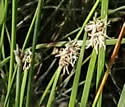 Eleocharis compressa plants
Eleocharis compressa plants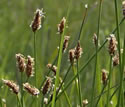 Eleocharis compressa plants
Eleocharis compressa plants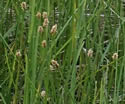 Eleocharis compressa plants
Eleocharis compressa plants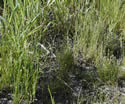 Eleocharis compressa with Eleocharis acicularis
Eleocharis compressa with Eleocharis acicularis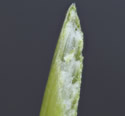 stem cross-sections
stem cross-sections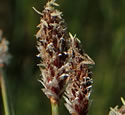 more spikes
more spikes comparison of Eleocharis compressa and E. elliptica scales
comparison of Eleocharis compressa and E. elliptica scales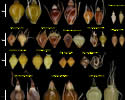 comparison of Minnesota's Eleocharis achenes
comparison of Minnesota's Eleocharis achenes
Photos by K. Chayka taken in Brown and Rock counties. Photos courtesy Peter M. Dziuk taken in Kittson County.
Comments
Have you seen this plant in Minnesota, or have any other comments about it?






